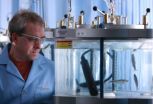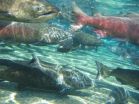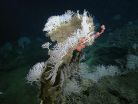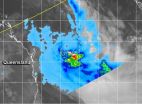(Press-News.org) RICHLAND, Wash. – Think of the pressure change you feel when an elevator zips you up multiple floors in a tall building. Imagine how you'd feel if that elevator carried you all the way up to the top of Mt. Everest – in the blink of an eye.
That's similar to what many fish experience when they travel through the turbulent waters near a dam. For some, the change in pressure is simply too big, too fast, and they die or are seriously injured.
In an article in the March issue of the journal Fisheries, ecologists from the Department of Energy's Pacific Northwest National Laboratory and colleagues from around the world explore ways to protect fish from the phenomenon, known as barotrauma.
Among the findings: Modifying turbines to minimize dramatic shifts in pressure offers an important way to keep fish safe when passing through dams. The research is part of a promising body of work that aims to reduce such injuries by improving turbine designs in dams around the world.
PNNL researchers are working with officials and scientists from Laos, Brazil, and Australia – areas where hydropower is booming – to apply lessons learned from experience in the Pacific Northwest, where salmon is king and water provides about two-thirds of the region's power. There, billions of dollars have been spent since 1950 to save salmon endangered largely by the environmental impact of hydropower.
"Hydropower is a tremendous resource, often available in areas far from other sources of power, and critical to the future of many people around the globe," said Richard Brown, a senior research scientist at PNNL and the lead author of the Fisheries paper.
"We want to help minimize the risk to fish while making it possible to bring power to schools, hospitals, and areas that desperately need it," added Brown.
Harnessing the power of water flowing downhill to spin turbines is the most convenient energy source in many parts of the world, and it's a clean, renewable source of energy to boot.
In Brazil, several dozen dams are planned along the Amazon, Madeira and Xingu rivers – an area that teems with more than 5,000 species of fish, and where some of the largest hydropower projects in the world are being built. In southeastern Australia, hydropower devices are planned in the area drained by the Murray-Darling river system. And in Southeast Asia, hundreds of dams and smaller hydro structures are planned in the Lower Mekong River Basin.
The authors say the findings from a collaboration that spans four continents improve our understanding of hydropower and will benefit fish around the globe. New results about species in the Mekong or Amazon regions, for instance, can inform fish-friendly practices in those regions of the United States where barotrauma has not been extensively studied.
To 'Everest' and back in an instant
Dams vary considerably in the challenges they pose to migrating fish, and the challenges are magnified when a fish must pass through more than one dam or hydro structure. At some, mortality is quite high, while at others, such as along the Columbia River, most fish are able to pass over or through a single dam safely, thanks to extensive measures to keep fish safe. Some fish spill harmlessly over the top, while others pass through pipes or other structures designed to route fish around the dam or steer them clear of the energy-producing turbines.
Still, at most dams, the tremendous turbulence of the water can hurt or disorient fish, and the blades of a turbine can strike them. The new study focuses on a third problem, barotrauma – damage that happens at some dams when a fish experiences a large change in pressure.
Depending on its specific path, a fish traveling through a dam can experience an enormous drop in pressure, similar to the change from sea level to the top of Mt. Everest, in an instant. Just as fast, as the waters swirl, the fish suddenly finds itself back at its normal pressure.
Those sudden changes can have a catastrophic effect on fish, most of which are equipped with an organ known as a swim bladder – like a balloon – to maintain buoyancy at a desired depth. When the fish goes deeper and pressures are greater, the swim bladder shrinks; when the fish rises and pressure is reduced, the organ increases in size.
For some fish, the pressure shift means the swim bladder instantly expands four-fold or eight-fold, like an air bag that inflates suddenly. This rapid expansion can result in internal injuries or even death.
Factors at play include the specific path of a fish, the amount of water going through a turbine, the design of the turbine, the depth of water where the fish usually lives, and the physiology of the fish itself.
"To customize a power plant that is the safest for the fish, you must understand the species of fish in that particular river, their physiology, and the depth at which they normally reside, as well as the tremendous forces that the fish can be subjected to," said Brown.
PNNL scientists have found that trying to keep minimum pressure higher in all areas near the turbine is key for preventing barotrauma. That reduces the amount of pressure change a fish is exposed to and is a crucial component for any turbine that is truly "fish friendly." Preventing those extremely low pressures also protects a turbine from damage, reducing shutdowns and costly repairs.
Lower Mekong River Basin
Brown and PNNL colleague Zhiqun (Daniel) Deng have made several trips to work with scientists in Southeast Asia, where dozens of dams are planned along the Mekong River and its tributaries. The Mekong starts out high in Tibet and travels more than 2,700 miles, touching China, Myanmar, Laos, Thailand, Cambodia, and Vietnam. The team estimates more than 1,200 species of fish make their home in the Mekong, including the giant Mekong catfish and the giant freshwater stingray, as well as the endangered Irrawaddy dolphin.
The scientists estimate that the region's fish account for almost half of the protein in the diet of the people of Laos and nearly 80 percent for the people of Cambodia. Four out of five households in the region rely heavily on fish for food, jobs, or both.
"Many people in Southeast Asia rely on fish both for food and their livelihood; it's a huge issue, crucial in the lives of many people. Hydropower is also a critical resource in the region," said Deng, a PNNL chief scientist and an author of the paper.
"Can we reduce the impact of dams on fish, to create a sustainable hydropower system and ensure the food supply and livelihoods of people in these regions? Can others learn from our experiences in the Pacific Northwest? This is why we do research in the laboratory – to make an impact in the real world, on people's lives," added Deng.
The same team of scientists just published a paper in the Journal of Renewable and Sustainable Energy, focusing broadly on creating sustainable hydro in the Lower Mekong River Basin. The paper discusses the potential for hydropower sources in the region (30 gigawatts), migratory patterns of its fish, the importance of fish-friendly technology, and further studies needed to understand hydro's impact on fish of the Mekong.
Authors of the Fisheries paper include scientists from PNNL, the National University of Laos, and the Living Aquatic Resources Research Center in Laos, the Federal University of São João Del-Rei in Brazil, the University of British Columbia; and from Australia, the Port Stephens Fisheries Institute in New South Wales, the Narrandera Fisheries Centre in New South Wales, and Fishway Consulting Services. PNNL's work in the area has been funded by the U.S. Army Corps of Engineers, DOE's Office of Energy Efficiency and Renewable Energy, and AusAid, the Australian Agency for International Development.
INFORMATION:
Reference: Richard S. Brown, Alison H. Colotelo, Brett D. Pflugrath, Craig A. Boys, Lee J. Baumgartner, Z. Daniel Deng, Luiz G.M. Silva, Colin J. Brauner, Martin Mallen-Cooper, Oudom Phonekhampeng, Garry Thorncraft, Douangkham Singhanouvong, Understanding barotrauma in fish passing hydro structures: a global strategy for sustainable development of water resources, Fisheries, March 2014, http://dx.doi.org/10.1080/03632415.2014.883570.
Making dams safer for fish around the world
Fish-friendly hydropower is the goal of international team
2014-04-14
ELSE PRESS RELEASES FROM THIS DATE:
Cosmic slurp
2014-04-14
Somewhere in the cosmos an ordinary galaxy spins, seemingly at slumber. Then all of a sudden, WHAM! A flash of light explodes from the galaxy's center. A star orbiting too close to the event horizon of the galaxy's central supermassive black hole is torn apart by the force of gravity, heating up its gas and sending out a beacon to the far reaches of the universe.
In a universe with tens of billions of galaxies, how would we see it? What would such a beacon look like? How would we distinguish it from other bright, monumental intergalactic events, like supernovas?
"Black ...
Researchers identify children with emotional behavior difficulties
2014-04-14
Research on children orphaned by HIV/AIDS in South Africa may provide insight on how to identify and help children with emotional behavior issues in other areas of the world, which may have limited access to healthcare and further research that could lead to successful interventions.
A report on the global AIDS epidemic published by the United Nations mentions that due to the HIV/AIDS pandemic, which has left 12 million children orphaned in Sub-Saharan African, children are at an increased risk for mental health problems.
"There has been a big push to understand what ...
Henry Ford Hospital hits new heart valve surgery milestone
2014-04-14
DETROIT – Doctors at Henry Ford Hospital reached a medical milestone April 3, performing the 25th successful transcatheter valve replacement using a novel way to access the heart.
Henry Ford is the only hospital in the United States performing the unique procedure called transcaval valve replacement, which accesses the heart by temporarily connecting major blood vessels.
Northern Michigan resident Viola Waller, 80, underwent Henry Ford's first transcaval procedure on July 3, 2013 when traditional valve replacement was not medically viable.
"Nobody could help me here," ...
Dog ownership benefits families of children with autism, MU researcher finds
2014-04-14
COLUMBIA, Mo. –Many families face the decision of whether to get a dog. For families of children with autism, the decision can be even more challenging. Now, a University of Missouri researcher has studied dog ownership decisions in families of children with autism and found, regardless of whether they owned dogs, the parents reported the benefits of dog ownership included companionship, stress relief and opportunities for their children to learn responsibility.
"Children with autism spectrum disorders often struggle with interacting with others, which can make it difficult ...
Rare bone diseases and their dental, oral and craniofacial manifestations
2014-04-14
Alexandria, Va., USA – The International and American Associations for Dental Research (IADR/AADR) have published a paper titled "Rare Bone Diseases and Their Dental, Oral, and Craniofacial Manifestations." The complete review by researchers Sunday O. Akintoye, Andrea B. Burke, Alison M. Boyce, Michael Collins, Brian L. Foster, Rachel I. Gafni, Janice S. Lee, Mary Scott Ramnitz, Martha J. Somerman and J. Timothy Wright is published in the OnlineFirst portion of the IADR/AADR Journal of Dental Research (JDR).
Hereditary diseases affecting the skeleton are heterogeneous ...
Researchers describe 4 new species of 'killer sponges' from the deep sea
2014-04-14
MOSS LANDING, CA — Killer sponges sound like creatures from a B-grade horror movie. In fact, they thrive in the lightless depths of the deep sea. Scientists first discovered that some sponges are carnivorous about 20 years ago. Since then only seven carnivorous species have been found in all of the northeastern Pacific. A new paper authored by MBARI marine biologist Lonny Lundsten and two Canadian researchers describes four new species of carnivorous sponges living on the deep seafloor, from the Pacific Northwest to Baja California.
A far cry from your basic kitchen sponge, ...
Babies prefer fairness -- but only if it benefits them -- in choosing a playmate
2014-04-14
A couple of years ago a University of Washington researcher who studies how children develop social behaviors like kindness and generosity noticed something odd. The 15-month-old infants in her experiments seemed to be playing favorites among the researchers on her team, being more inclined to share toys or play with some researchers than others.
"It's not like one experimenter was nicer or friendlier to the babies – we control for factors like that," said Jessica Sommerville, a UW associate professor of psychology. She took a closer look at the data and realized that ...
NASA sees Tropical Cyclone Ita over the Coral Sea
2014-04-14
Tropical Cyclone Ita made landfall in northeastern Queensland, Australia on April 11 as a powerful Category 4 hurricane on the Saffir-Simpson scale, moved south and re-emerged in the Coral Sea on April 14 where NASA's TRMM and NASA-NOAA's Suomi NPP Satellites captured imagery of the weakened storm.
The VIIRS instrument aboard NASA-NOAA's Suomi NPP satellite captured a visible look at Ita's elongating structure on April 14 at 4:12 UTC/12:12. The Visible Infrared Imaging Radiometer Suite (VIIRS) instrument collects visible and infrared imagery and global observations of ...
Website information on colon cancer too complex, fails to address key concerns
2014-04-14
DALLAS – April 14, 2014 – Popular web information on colorectal cancer is too difficult for most lay people to read and doesn't address the appropriate risks to and concerns of patients, a study by UT Southwestern Medical Center gastroenterologists suggests.
In a review of a dozen popular websites, most of the online patient education materials for colorectal cancer screening were written beyond the recommended sixth-grade reading level, while content on the sites failed to address key risks, as well as the barriers to and benefits of screening, according to the study's ...
Beam on target!
2014-04-14
Late on April 1, the crown jewel of the Department of Energy's Thomas Jefferson National Accelerator Facility ("Jefferson Lab") sparkled its way into a new era. Following an upgrade of the Continuous Electron Beam Accelerator Facility, the CEBAF accelerator delivered the highest-energy electron beams it has ever produced into a target in an experimental hall, recording the first data of the 12 GeV era. The machine sent electrons around the racetrack three times (known as "3-pass" beam), resulting in 6.11 GeV electrons at 2 nanoAmps average current for more than an hour.
"This ...
LAST 30 PRESS RELEASES:
Structure of dopamine-releasing neurons relates to the type of circuits they form for smell-processing
Reducing social isolation protects the brain in later life
Keeping the heart healthy increases longevity even after cancer
Young adults commonly mix cannabis with nicotine and tobacco
Comprehensive review illuminates tau protein's dual nature in brain health, disease, and emerging psychiatric connections
Book prepares K-12 leaders for the next public health crisis
Storms in the Southern Ocean mitigates global warming
Seals on the move: Research reveals key data for offshore development and international ecology
Sports injuries sustained during your period might be more severe
World's first successful 2 Tbit/s free-space optical communication using small optical terminals mountable on satellites and HAPS
Can intimate relationships affect your heart? New study says ‘yes’
Scalable and healable gradient textiles for multi‑scenario radiative cooling via bicomponent blow spinning
Research shows informed traders never let a good climate crisis go to waste
Intelligent XGBoost framework enhances asphalt pavement skid resistance assessment
Dual-function biomaterials for postoperative osteosarcoma: Tumor suppression and bone regeneration
New framework reveals where transport emissions concentrate in Singapore
NTP-enhanced lattice oxygen activation in Ce-Co catalysts for low-temperature soot combustion
Synergistic interface engineering in Cu-Zn-Ce catalysts for efficient CO2 hydrogenation to methanol
COVID-19 leaves a lasting mark on the human brain
Scientists use ultrasound to soften and treat cancer tumors without damaging healthy tissue
Community swimming program for Black youth boosts skills, sense of belonging, study finds
Specific depressive symptoms in midlife linked to increased dementia risk
An ‘illuminating’ design sheds light on cholesterol
Who is more likely to get long COVID?
Study showcases resilience and rapid growth of “living rocks”
Naval Research Lab diver earns Office of Naval Research 2025 Sailor of the Year
New Mayo-led study establishes practical definition for rapidly progressive dementia
Fossil fuel industry’s “climate false solutions” reinforce its power and aggravate environmental injustice
Researchers reveal bias in a widely used measure of algorithm performance
Alcohol causes cancer. A study from IOCB Prague confirms damage to DNA and shows how cells defend against it
[Press-News.org] Making dams safer for fish around the worldFish-friendly hydropower is the goal of international team










